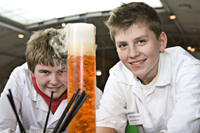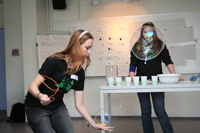Science centres working with schools: using peer-to-peer teaching to engage students Inspire article
Sheena Laursen from Experimentarium in Denmark describes how the centre’s Xciter project helps students motivate each other to delve deeper into science.

The Danish ROSE (Relevance of Science Education)w1 investigation shows that science is not popular among 15-year-olds at school. Very few students – particularly girls – see science as the foundation for a promising career. If we wish to motivate young students to take a greater interest in science subjects, we need to look at new ways and new perspectives of teaching science in schools.
The Xciter perspective
The Xciters projectw2 combines the experience of communicating science in informal settings such as science centres with the more formal approach that exists in school settings. As a science centre, Experimentariumw3 has a long tradition of communicating science by actively involving the audience; school-teachers attached to this project bring not only great experience in teaching science but also an in-depth knowledge of their students’ understanding of science.
What is an Xciter?
Xciters are young science communicators in Year 6 (ages 13-14) who become catalysts for the project by spreading their knowledge and inspiring their peers. The overall goal of the Xciters project is to motivate older school students in Denmark (ages 12-16) to become more interested in science topics, and to increase the status of science subjects among these students. Xciters are interested in science, like to experiment and want to pass on their knowledge. The Xciters course gives them both the tools and the ability to achieve this.
In the long term, the Xciters project could encourage more students to choose further scientific studies and careers. Xciters is one of the activities in the PENCIL projectw4 and has gained funding from the Egmont Foundation to continue for five more years.
How Xciters works

Three students (ages 13-14) from each science class and their teacher apply to take part in a science communication course at Experimentarium. Those who are selected take part in two three-day training courses run by science education experts and explainers from Experimentarium. The courses, which take place during school time, mix scientific knowledge, hands-on experiments and communication tools, presenting new methods of teaching to the teachers and students.
As fully qualified Xciters, the young science communicators return to their schools and share their knowledge with fellow students through a combination of experiments and dialogue. They lead workshops for fellow Year 7 students, training all students in the year as Xciters and sharing with them their excitement about the project. The Xciters then work in pairs on peer-to-peer presentations for younger students (one or two years younger): planning which experiments to show and how to interact with their audience of up to eight fellow students.
Over the course of the year, Experimentarium visits the schools and stays in close contact with teachers. Teachers can read and download material on the Xciters websitew2 and contact Experimentarium staff if they have questions.
A series of scripts with detailed facts about the scientific topic supports the students in their mentoring efforts. Typical biology, physics or chemistry topics include the lung and the body’s circulation, the physics of sound, and various states of water. A ‘tips and tricks’ manual provides the students with good science communication advice and tools. In the teacher’s manual, inspirational pieces demonstrate how to present the different topics and how to communicate effectively.
Teaching materials on three topics can be found on the Xciters website. For example, in the ‘eye’ materials (available in English), students are guided through the steps of an eye dissection and are provided with the necessary factual knowledge such as the physiology of the eye and how lenses work. In addition, there are suggestions for involving the audience, creating dialogue, and questions to ask.
Comments on Xciters
From teachers
ente Kold-Christensen from Maglegaard School near Copenhagen has participated in Xciters with students from three classes. Bente is currently educating new Xciters in close collaboration with former Xciters.
“It is a task I am looking forward to, as it will show whether we are able to give other children the same wonderful experience of passing science on to fellow classmates as the original Xciters had. It has to be cool to be good at science. All the students in my Year-8 class (age 14) are now experienced Xciters. The method is a great way of engaging students in science lessons. One of my colleagues recently saw my students in their role as Xciters and commented that if he hadn’t seen their concentration with his own eyes he wouldn’t have believed it! That’s when you realise what a pleasure it is being a teacher.”
Jeppe Thygesen from Gorlev School in the south of Zealand in Denmark has just completed the full Xciters course.
“It is a good way to work with science in school. It creates a broader focus and also a better environment for learning about science. The students’ own knowledge and confidence grows as they pass on their knowledge and experiences, which they do very well.
Connecting science with everyday life also means that the facts are more easily remembered. The project has given the younger classes a good insight into the world of science and many of the younger students have asked if they can come back and see the ‘bigger children’ performing their experiments.”
From students
“You learn a lot when you have to teach others.”
“I didn’t think I would be so good at this, but I found out that I actually was quite good.”
“Our science subjects have become so wonderfully different, because you can’t predict what is going to happen.”
Peer-to-peer inspiration
Xciters is inspired by the ‘learning by teaching’ strategy or ‘peer-to-peer’ teaching often used in Danish schools when the focus is on emotional topics. This approach helps young people to discuss openly on a level they can refer to and understand. One advantage of using peer-to-peer teaching in science is that it puts the subjects into a context that is attainable and ‘cool to be a part of’.
The pedagogical idea behind the project is that working toward communicating science is more motivating than just listening. Preliminary results indicate that the Xciter students become more interested in science. They also develop confidence in their communication skills, abilities and their knowledge of science subjects. Whether the students taught by the Xciters benefit is yet to be evaluated. What we do know is that the students taught by Xciters talk a great deal about what they have learned and about the experience afterwards, that the bond between the younger students and the older Xciter students is strengthened, and that the younger students look up to the older ones. Many have asked their teachers if they could become Xciters when they are older.
The Xciter method attracts both girls and boys, and they inspire and learn from each other. It seems that the girls naturally employ a communicative approach and boys seem to learn from their enthusiasm, whereas boys seem to be more confident in their knowledge and plunge into experiments from which, in turn, the girls learn.
Qualitative and quantitative evaluations
The first annual evaluation of participating teachers indicated that the project is fulfilling its primary objective: to increase interest in scientific subjects among the school students involved as Xciters. This ongoing evaluation by the Danish University of Education combines both qualitative and quantitative methods.
The beauty of Xciters is that the project need not be limited to school science – it can also be implemented and employed within other subject areas and educational fields. So the opportunities it offers to the scholars of today and tomorrow are many and varied.
PENCIL
Xciters is one of the activities in the PENCIL projectw4 (Permanent EuropeaN resource Centre for Informal Learning). PENCIL, co-ordinated by Ecsitew5 and funded by the European Commission as part of the NUCLEUS clusterw6, aims to strengthen the operational relations between schools and informal science education in science centres and museums. Fourteen science centres and museums have developed pilot activities in partnership with teachers and schools; material is already available online. Academic and school partners are now working to identify key ways to transform informal science activities into innovative, high-quality tools for science teaching.
Experimentarium
IExperimentarium is a science communication and activity centre for nature, technology, health and the environment. The aim of Experimentarium is to promote interest in natural science and technology. Since it opened in 1991, 5.6 million people have visited Experimentarium. Of the annual 350 000 guests, 110 000 are school visits. As well as housing science exhibits, Experimentarium develops a diversity of science communication and outreach projects, often in close collaboration with schools.
Web References
- w1 – For information about the ROSE study of students’ attitudes to science, see:
- Sjøberg S, Schreiner C (2006) How do students perceive science and technology? Science in School 1: 66-69.
- and the ROSE study website.
- w2 – The Xciters website
- w3 – The Experimentarium website
- w4 – Information about PENCIL is available on the Xplora website
- w5 – The website of Ecsite, the European organisation representing science centres and museums
- w6 – Information about NUCLEUS is available on the Xplora website





